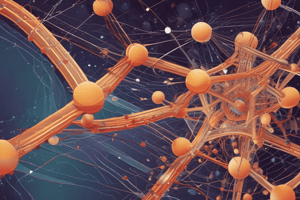Podcast
Questions and Answers
What happens to particles in a solid as heat is applied?
What happens to particles in a solid as heat is applied?
- They move rapidly past each other.
- They start to vibrate more rapidly. (correct)
- They begin to flow freely.
- They remain stationary.
What is a characteristic of particles in a liquid state?
What is a characteristic of particles in a liquid state?
- They are fixed in place.
- They can move within a fixed shape. (correct)
- They cannot change volume.
- They are far apart.
What is a key difference between the solid and liquid states?
What is a key difference between the solid and liquid states?
- Particle movement (correct)
- Particle arrangement
- Intermolecular forces
- Volume of the substance
In which state of matter are intermolecular interactions negligible?
In which state of matter are intermolecular interactions negligible?
What is true about the shape of a solid?
What is true about the shape of a solid?
What happens to a solid as more heat is applied?
What happens to a solid as more heat is applied?
What is a characteristic of particles in a gas state?
What is a characteristic of particles in a gas state?
What is true about the volume of a liquid?
What is true about the volume of a liquid?
What happens when gas molecules collide with other molecules or the walls of the container?
What happens when gas molecules collide with other molecules or the walls of the container?
What is a characteristic of gases?
What is a characteristic of gases?
What happens to gas molecules if exposed to space?
What happens to gas molecules if exposed to space?
What is a characteristic of the plasma state?
What is a characteristic of the plasma state?
What is the most common state of matter in the universe?
What is the most common state of matter in the universe?
What is an example of the plasma state on Earth?
What is an example of the plasma state on Earth?
Flashcards are hidden until you start studying
Study Notes
States of Matter
- Matter exists in four physical states or phases: solid (s), liquid (l), gas (g), and plasma.
- The states of matter can be transitioned from one to another by applying heat, with the sequence being solid → liquid → gas → plasma.
Solid State
- Particles (atoms or molecules) are very close to each other and held strongly by intermolecular forces.
- Particles can vibrate around their mean positions but cannot slide past each other.
- Solids have a fixed shape and a fixed volume.
- Expansion and contraction are negligible in the solid state.
Liquid State
- Particles are close enough to experience strong intermolecular interactions, preventing them from crossing the liquid boundary.
- Particles can move around within the liquid, allowing them to flow and acquire the shape of the container.
- Liquids have a fixed volume but no fixed shape.
- Expansion and contraction are negligible in the liquid state.
Gas State
- Particles are far apart, with negligible intermolecular interactions.
- Gas molecules move in straight lines in random directions until they collide with other molecules or the container walls.
- Collisions are elastic, conserving the total kinetic energy of the system.
- Gases can flow, acquire the shape of the container, and expand or contract to fill the available space.
- Gases do not have a fixed shape or a fixed volume.
Plasma State
- Particles are far apart, similar to gases, but with a portion of the negative charge (electrons) separated from the positive charge (nucleus).
- Atoms in the plasma state are ionized.
- Plasma is the most common state of matter in the universe, but rare on Earth.
- Examples of plasma on Earth include matter in electrical arcs, lightning, and neon signs.
Studying That Suits You
Use AI to generate personalized quizzes and flashcards to suit your learning preferences.



